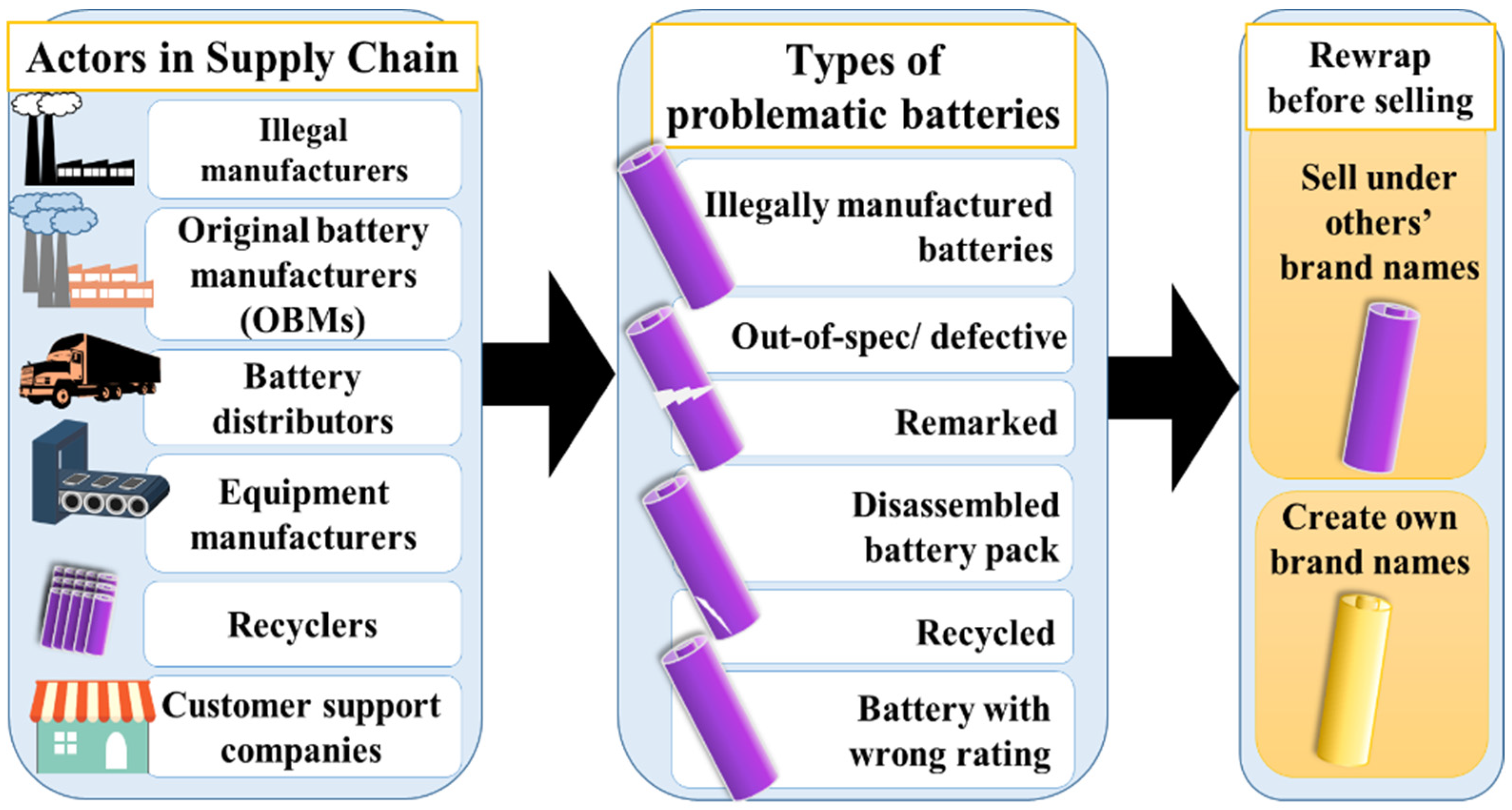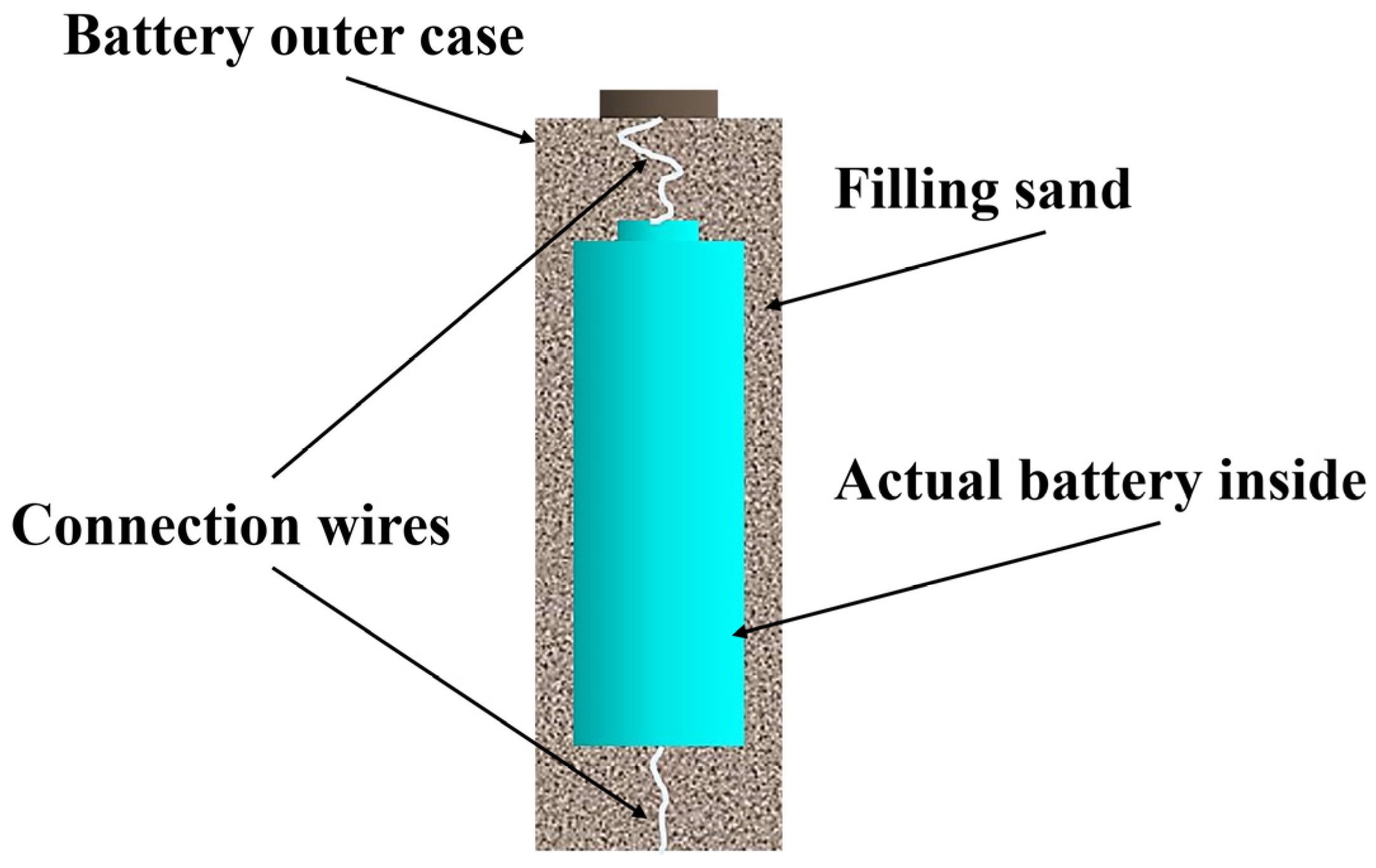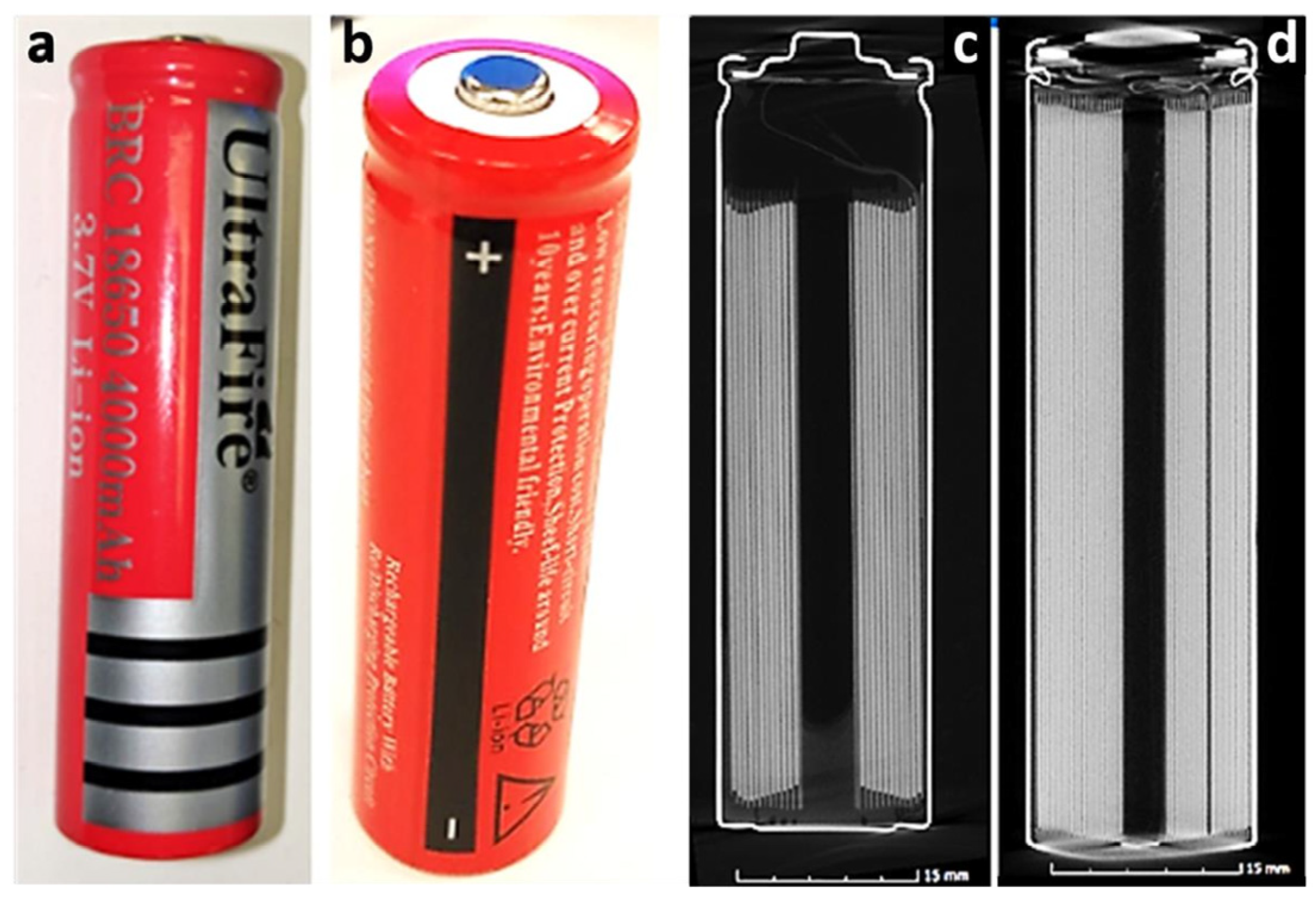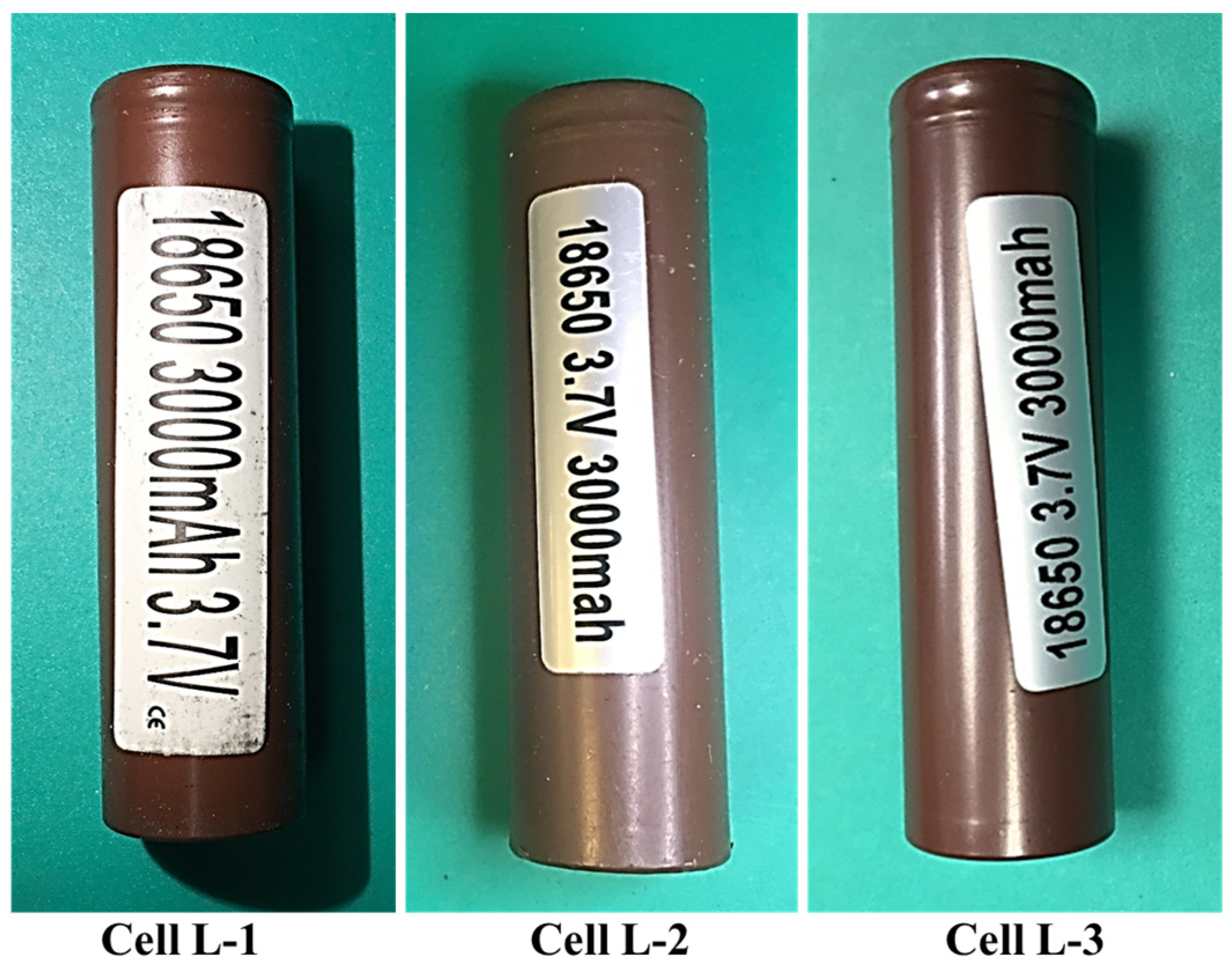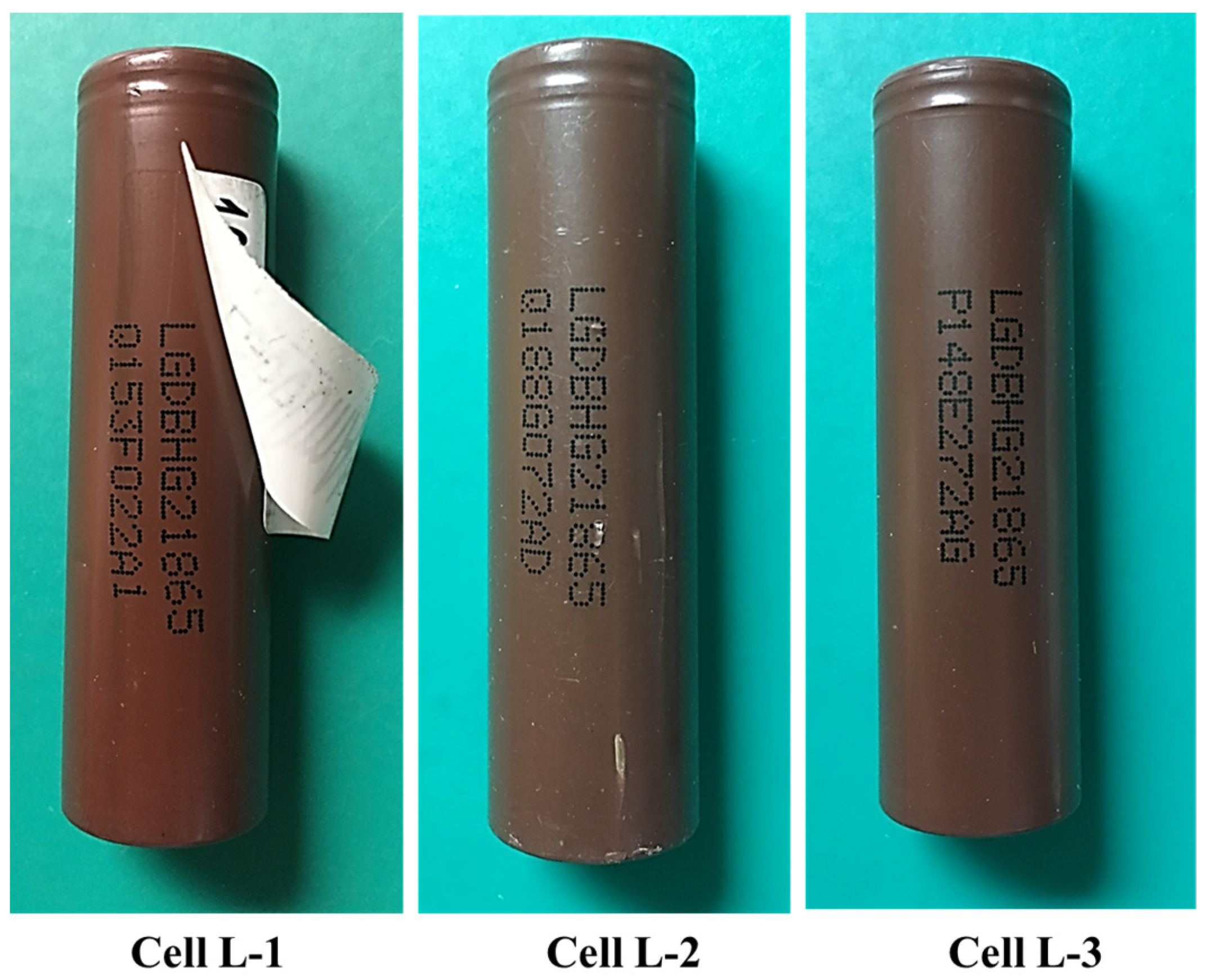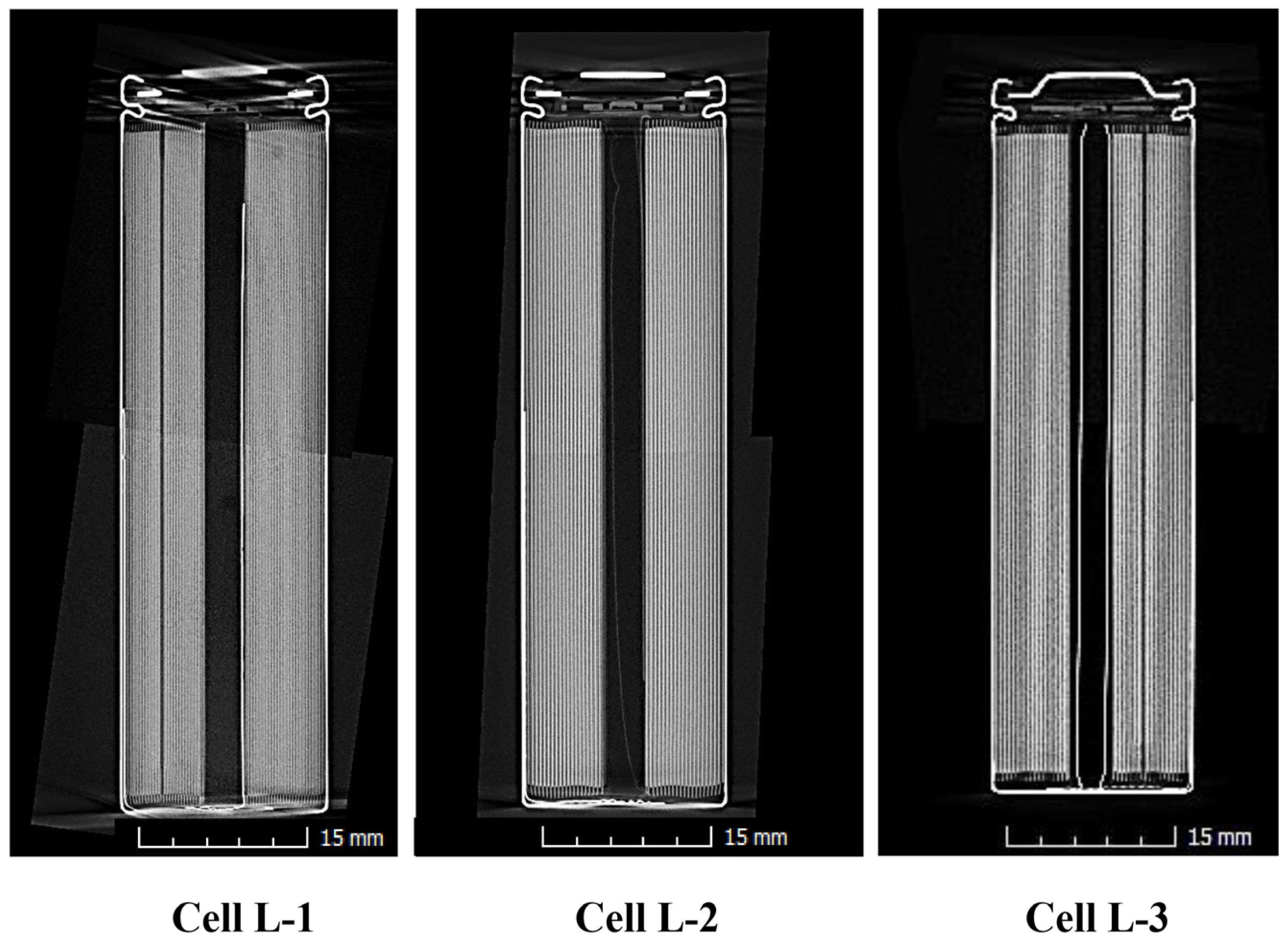1. Introduction
Compared with previous rechargeable batteries, such as lead-acid batteries or nickel–metal hydride batteries, lithium-ion batteries have higher energy density and power density [
1]. Lithium-ion batteries have become the dominant power source for mobile phones, notebooks, power banks, and electric cars [
2]. In 2020, the global lithium-ion battery market was estimated to range from 40.5 [
3] to 53.6 billion U.S. dollars [
4]. A certain portion of the huge number of batteries used among us is counterfeited. In 2003, roughly 5 million counterfeit cellular phone batteries were seized worldwide [
5]. In 2016, in a case related to hoverboards with counterfeit batteries, the U.S. customs and border protection agency seized over 16 thousand counterfeit hoverboards with an estimated value of over USD 6 million [
6].
Using counterfeit batteries with an exaggerated claim of capacity than they really have can make the battery work under unacceptable stress conditions. In the worst case, if a workload is applied to a counterfeit battery based on the exaggerated rating, the battery may cause unsafe conditions. Because of the flammable nature of organic electrolytes, overstressed lithium-ion batteries can potentially result in fire or an explosion. During a thermal runaway event, exothermic reactions lead to a rapid increase in the internal battery temperature, and the battery temperature can be as high as 943 °C [
7].
Counterfeiting is not unique to lithium-ion batteries. According to the US Department of Homeland Security, 23,140 shipments of counterfeit goods valued at about USD 1.2 billion were seized in 2014 [
8]. SAE Standard AS6171 classified counterfeit products into seven categories: recycled/reworked, remarked, overproduced, out-of-specification/defective, cloned, forged documentation/part substitution, and tampered. The classification encompasses the nature of the counterfeiting and, in some cases, how it is sourced. Counterfeit lithium-ion batteries can come from defective batteries, rewrapped batteries, and illegally manufactured batteries.
Battery accessories such as the battery charger can also be counterfeited, such as those from Sony and Nikon [
9,
10]. However, based on the examples of manufacturers’ announcements, the well-known battery manufacturers are not aiming at individual consumers but device manufacturers who demand large battery packs. However, the handling of the premade battery packs is not monitored. There exists the opportunity for disassembling the battery packs into individual cells and rewrapping them for sale.
Counterfeit batteries include the defective batteries from the OBM (original battery manufacturer), illegally manufactured batteries, and recycled batteries.
Figure 1 shows an example of a high-risk lithium-ion battery supply chain. These batteries may look like newly manufactured, good-quality batteries but turn out to be rewrapped, defective, or illegally manufactured batteries from a third party under well-known companies or self-created brand names. Rewrapped batteries can be used cells whose capacity and max allowable discharge current deviate from the original specification.
Without thorough characterization and correct battery rating label, the degradation level and the remaining useful life of a rewrapped battery are unknown. Compared with a good-quality battery, the remaining useful life for a degraded battery with lower actual capacity is unknown. There may be no life test conducted on these problematic batteries. It is also not guaranteed that all the batteries are running in their safe operating range. Thus, using these batteries can be dangerous. The real manufacturer is unknown for rewrapped batteries sold under others’ brand names. In case of problems, the marketplace refers to the company whose name appears on the label. Thus, OBMs involved in the counterfeit batteries related to injury or property legal cases released warnings and some guidance for consumers to detect the counterfeit batteries, trying to put the responsibility on the consumers. However, these activities from the OBMs have limited effectiveness in preventing or eliminating counterfeit batteries.
The supply chain can be divided into the battery and device supply chains. After manufacturing lithium-ion batteries, the first step of battery transfer in the battery supply chain is from the OBMs to the device manufacturer. LG, Samsung, Sony, and Maxell are examples of OBMs, and the batteries they produce are supplied to the device manufacturers. For device manufacturers, batteries are either embedded in their product or replaceable that the consumer can change to third-party batteries later. In one situation, the OBM sells batteries to battery distributors (for example, Sekorm is the distributor of Maxell), and then the battery distributor sells the battery to the device manufacturer. In the other situation, the OBM can also take the role of a battery distributor and directly sell their batteries to the device manufacturers. In both situations, the battery sold in large volumes of hundreds of thousands. For the second part, the device supply chain covers the steps from the device manufacturers where the devices are manufactured to the consumers.
Counterfeit batteries can enter the supply chain from the OBMs, battery distributors, device manufacturers, and retailers. Devices with embedded batteries prevent the consumer from replacing the battery. Devices with replaceable batteries are more likely to have counterfeits or lower quality batteries after such replacements since individuals are not in a position to perform analyses to detect such batteries. Customer safety should come first, and the device manufacturers following embedded should also provide battery replacement services to consumers at a reasonable price. Counterfeit battery sellers are using online trading platforms to spread counterfeit batteries further. Online trading platforms, including Amazon and eBay, are all involved in cases of counterfeit batteries in the past [
11,
12]. Worldwide, it is reported that 3.3% of the global trade (2019) was counterfeit and pirated goods, and the U.S. is the most affected country, where seized fake products counted for 24% in 2016 [
13]. Even one single person can sell a large volume of counterfeit batteries into the market. In late 2019, one counterfeit scheme involved around USD 24 million worth of counterfeit batteries for laptop computers [
14].
Distributors who do not manufacture lithium-ion batteries can build their brands by rewrapping lithium-ion batteries from various sources. For electronic components, standards like IPC-1752 require companies in the supply chain to share information on constituent materials. However, similar standards do not exist for counterfeit lithium-ion batteries. In addition, similar regulations may not be suitable for lithium-ion batteries because the lithium-ion battery components are permanently sealed within their cases. As a result, costly and time-consuming material analyses are necessary for authentication.
Identifying counterfeit lithium-ion batteries requires expertise and knowledge, which are unlikely to be accessible to individual customers. The current method for distinguishing counterfeit batteries involves inspecting the wrapper. For example, readily available guidance about identifying counterfeit batteries involves simple tests, such as comparing the outer case color and labels with the genuine product [
15]. These methods focus on inspecting the outer battery wrapper from the manufacturer, which can also be counterfeited. Sometimes, there are third-party organizations independent from OBMs, that provide authentication marks to the products. The South Korean law “Electrical Appliances and Consumer Products Safety Control Act 19 [
16]” even banned products without the “safety assurance mark” from distribution. Even the authentication of the qualified battery markings can be counterfeited. Determining the authenticity of batteries by inspecting the accompanying markings is unreliable. In 2013, Underwriters Laboratories (UL) released a list and photos of counterfeit lithium-ion batteries labeled with a forged UL marking [
17]. UL 8139 standard 2018 on product markings requires that the markings for electrical systems of electronic cigarettes “shall be permanent” [
18]. Although the UL 8139 is focused on electronic cigarettes, the same concept can be applied to the entire battery market to cover the battery marks.
Counterfeit products are known in the industrial field before the commercialization of lithium-ion batteries, and there are established standards, such as SAE AS6171, for determining counterfeit electronic components. SAE AS6171 guides “inspection and procedure, workmanship criteria, and minimum training and certification requirements to detect Suspect/Counterfeit (SC) Electrical, Electronic, and Electromechanical (EEE) parts” [
19]. However, the existing standard covers electrical, electronic, and electromechanical parts. Batteries are covered under that standard. SAE standard, AS7492, is currently under development, but it is not close to publication.
This paper analyzes the supply chain in the lithium-ion battery market and classifies the possible sources of counterfeit batteries based on the supply chain nodes where counterfeit batteries enter the market. The paper also critically examines some of the actions taken by battery manufacturers and resellers and reveals their limitations.
Section 2 discusses the issues of battery counterfeiting and original battery manufacturers that can impact the counterfeit problem. The potential hazard of the counterfeit lithium-ion battery issues is analyzed and presented in
Section 3.
Section 4 reports the analysis results of several LG batteries as a case study. Recommendations on reducing counterfeit batteries in the supply are covered in
Section 5.
2. Battery Counterfeiting
With the popularity of lithium-ion batteries, there are increasing concerns about battery quality, safety, and durability due to the increasing reports of lithium-ion battery-related incidents. Counterfeit lithium-ion batteries are usually less expensive than genuine ones [
20] because it is unlikely that a counterfeiter would spend the resources for proper design, qualification, quality control, or supply chain management. In addition, these batteries may not have protective devices [
21] against overcharging or thermal runaway. As a result, counterfeit batteries have a higher potential risk of overheating or fire [
22].
Battery counterfeiting activities usually aim at well-known brands in the market and use people’s trust in well-known brands to sell counterfeit and unreliable products. E-cigarettes are considered a typical market prone to counterfeit lithium-ion batteries [
23]. Batteries sold individually as spares or replacements in e-cigarette applications could be counterfeit or rewrapped. Sony, a major OBM, asserted that the 18,650 battery is not designed for e-cigarette usage but manufacturers of power products [
24]. Still, Sony’s VTC 18,650 battery is highly recommended on almost every e-cigarette consumer online forum because it can provide a higher current than other similar-sized batteries. Although Sony transferred its battery business to Murata Manufacturing in 2016 [
25], Sony 18,650 batteries are still entering the e-cigarette market. Some of these batteries may even be genuine, but they may have been classified as lower-grade batteries by the OBM, who received them from Sony. In January 2021, the U.S. Consumer Product Safety Commission (CPSC) released a warning to consumers “not to buy or use loose 18,650 lithium-ion battery cells. These cells are manufactured as industrial components of battery packs and are not intended for individual sale to consumers”. However, they are being separated, rewrapped and sold as new consumer batteries, typically on the Internet” [
26]. Battery cells are sometimes pulled from larger battery packs and rewrapped [
27]. In addition to the above-mentioned possible source of rewrapped low-quality batteries, the rest of the batteries available in the e-cigarette market may be just counterfeit products.
Various battery manufacturers are facing the issue of rewrapped batteries, such as Sony, LG Chem, and Samsung. Brand manufacturers are aware of the counterfeit issues, and they have brought these issues to the public’s attention. Sony warns that “misuse of Sony Li-ion cells in E-cigarettes and vape pens may cause a serious risk to personal property and safety” [
24]. As a countermeasure, Sony has built its retail stores [
28], which can get products from the manufacturer directly and significantly reduce the possibility of allowing counterfeit batteries to enter the market. Another popular brand among e-cigarette users is LG Chem, which warned against the use of its batteries in e-cigarette applications. LG Chem stated that “LG Chem’s batteries are not authorized, approved, or intended for sale or use by individual consumers as original or replacement power sources in these devices (E-cigarette)” [
29]. Counterfeit batteries are not limited to the e-cigarette market; Nikon and Canon are also facing the problem of counterfeit battery issues in other markets.
Without establishing a universal battery tracking system along the supply chain, the effect of the original brand holders’ independent activities could be limited. The counterfeit batteries can still be available to the consumers from other nodes in the supply chain. Most OBMs do not directly interact with their final customers. OBMs sell batteries to the equipment manufacturers who incorporate batteries into the devices to serve as the power source. In a typical lithium-ion battery-powered electronic devices supply chain, there are several nodes in the battery supply chain before the battery reaches the end-user. In the case of a battery incident, various entities may be found responsible for the same incident due to the nature of the battery supply chain. For example, in a 2015 lawsuit, a woman injured by an exploded battery in an e-cigarette was awarded nearly USD 1.9 million from the local e-cigarette store, the distributor, and the wholesaler. They were all found responsible for the injury [
30]. In this case, although it was not mentioned whether the battery was identified as counterfeit or not, the quality issues influenced the entire supply chain.
3. Potential Hazard of Counterfeit Batteries
Counterfeiting activities vary from remarking an original product to illegally manufacturing the product based on the original design, reverse engineering, or new design [
31]. Selling these batteries as products of a different and typically more well-known company is an example of counterfeiting. Counterfeit batteries may look like newly manufactured, good-quality batteries from the OBM but turn out to be rewrapped, defective, or illegally manufactured batteries from a third party under well-known companies or self-created brand names. In this study, the sale of rewrapped and defective cells is also regarded as counterfeiting. The aged cells used for rewrapping have lower capacity and max allowable discharge current than the original specification. Without thorough characterization, the quality and uniformity of rewrapped batteries are questionable. Compared with a good-quality battery, a defective battery will likely degrade faster in any operating condition. It is not practical to run a full life test on these problematic batteries, and the actual application situation can include a wide range of electrical profiles. It is impossible to guarantee that all the batteries are always running in their safe operating range. Thus, using these batteries can be as dangerous as using illegally manufactured batteries. Compared with the SAE AS6171, terms for counterfeit lithium-ion batteries are defective batteries (out-of-specification/defective), rewrapped batteries (recycled/reworked, remarked, forged documentation/part substitution, tampered), and illegally manufactured batteries (cloned). Defective batteries can be from the original battery manufacturers (OBMs).
Rewrapped and illegally manufactured batteries fall in a different category of possible fraudulent or unlawful actions. Rewrapped batteries may have been initially sold by the OBM to a company to be used as a battery pack which is not intended to be sold to individual customers directly. However, these battery packs can be separated and rewrapped as individual cells to sell to individual customers. Some of these used batteries can be wrapped with a new covering to make them appear new. Rewrapped batteries may also be defective or substandard batteries meant to be discarded but sold with original or off-brand labels. Because of the mislabeling, a rewrapped battery may be used in unexpected usage conditions increasing risks to the consumer.
The outer wrapper of a battery covers the outer metal case and prevents potential short circuits [
32]. Although different battery wrappers contain different types of information, the battery wrapper can also provide the brand name, nominal voltage, capacity, and notice to consumers. However, some distributors use the wrapper to build up their brand. These distributors do not manufacture batteries but can rewrap batteries from other manufacturers [
33]. Rewrapped batteries come from various sources, including recycled and defective battery sources. There could be scratches left on the battery metal outer case. However, once these batteries are rewrapped with a new cover, they may appear new. The counterfeit batteries may not meet the designed capacity or electrical specifications [
34], and even if they do, they are unlikely to meet other design and material specifications of the original design.
Counterfeit batteries made through rewrapping can make a 18,350 look like a 18,650 cell. Compared with 18,650 batteries (65 mm length), 18,350 batteries are much shorter (35 mm length). During rewrapping, a 18,350 cell can be connected to a step-up circuit, and the gap between the 18,350 and 18,650 filled with fillings and paper to make it appear to be of the same size as a 18,650 cell [
35].
Figure 2 schematically illustrates how this kind of counterfeit battery is constructed.
Specifications of the rewrapped batteries can be inaccurate. For example, many batteries are available online under the brand name UltraFire. The labeled battery capacity varies significantly, and some of the batteries even claim a capacity as high as 4000 mAh. However, according to an UltraFire statement [
36], they never manufactured any battery that can reach a capacity as high as 4000 mAh, so those batteries are counterfeit.
Figure 3 shows the internal structure difference between a counterfeit battery and a genuine product [
37]. These rewrapped batteries do not likely meet the datasheet specifications of the authentic product and may not be suitable for some applications. The proliferation of counterfeit batteries increases the potential hazards of battery incidents. A significant concern is a thermal runaway, where the thermal energy released from a battery [
38] can result in a battery fire or explosion.
Manufacturers’ guidance is mainly about the printing quality of the wrapper or the label on the batteries. Still, these are not reliable since the wrapper or the label can also be counterfeited. In addition, counterfeit batteries lack active energy storage materials and are equipped with fewer safety features. This lack of active material means that the counterfeit batteries cannot meet the specified capacity asserted. In some cases, the capacity is exaggerated, which results in the battery working in an overstressed condition. In addition, counterfeit batteries may be offered at an attractive price, at the cost of lower quality control and few safety features (against fire or explosion).
The counterfeit UltraFire battery has no vent holes or other safety mechanisms, making it more vulnerable to potential thermal runaway hazards than the genuine product. Nikon [
39] also warns that “Counterfeit products may not be equipped with safety mechanisms such as the protection device”. Genuine lithium-ion batteries are equipped with protective devices, including positive temperature coefficient thermistor (PTC), current interrupt device (CID), and safety vent [
40]. However, counterfeit batteries can omit these protective devices to reduce the cost. In practice, counterfeit batteries may be overstressed even in normal use conditions. For instance, a man was injured during an incident caused by an inexpensive counterfeit phone battery explosion. The battery explosion resulted in deep burns on his cheek and neck and fractured his skull [
41].
There is almost no technical barrier to prevent fraudulent manufacturers from making counterfeit lithium-ion batteries using the name of an original brand holder. A well-trained worker can assemble a lithium-ion battery in minutes from relatively readily available materials, using commonly available equipment. Furthermore, a purchaser will generally find it difficult to visually observe whether a lithium-ion battery is counterfeit or not [
42]. Some companies released guidance to consumers for telling the counterfeit battery based on the lower quality of the printed logo. Canon’s website advises customers on avoiding counterfeit Canon lithium-ion batteries [
43]. Sony also warns customers that a genuine battery always has a clear printed logo, whereas the logo on a counterfeit battery may be “blurry, sloppy, off-color, or misplaced” [
22]. However, these warnings from manufacturers cannot exclude the counterfeit batteries from entering the market from other nodes on the supply chain, and the guidance for distinguishing the counterfeit batteries is mainly about observing the outer case of the battery, which is not reliable.
Many electronic cigarettes use replaceable 18,650 cylindrical lithium-ion batteries as the power sources, which forces the customer to find replacements when those batteries reach the end of life. Saxena et al. [
44] investigated the e-cigarette fire and explosion incidents. They found that “The sudden rise in the e-cigarette market and user base, absence of proper business and testing regulations, long supply chains, and lack of awareness among e-cigarette users have provided an environment for the distribution of defective and substandard batteries”.
4. Case Study
Because of the various sources of batteries and the changes made by the original battery manufacturers among different versions, even batteries under the same brand name could have notable differences. This case study presents an example of inconsistent lithium-ion battery structures sharing the same brand name to illustrate the efforts required to identify counterfeit lithium-ion batteries. Three LG 18,650 batteries from different distributors (shown in
Figure 4) are used for comparison. These batteries are the same type of batteries that resulted in e-cigarette explosion incidents. They were purchased from the general market. However, since LG claims that it does not sell 18,650 batteries to individual customers, it cannot be assumed that any one of those was authentic. When specifications, including dimensions, weight, impedance, and capacity, are available for authentic batteries, battery parameters from questionable batteries can be compared to these specifications as indicators of the battery being counterfeit. If an authentic battery is available, the battery materials and marking codes can also be compared. The text font and size on the label are different, but all the batteries claim a 3000 mAh capacity and 3.7 V output voltage. The outer casings of all three batteries are brown. Electrical tests could not be conducted on exploded batteries, but for other related batteries, the batteries generally tested as good.
As shown in
Figure 5, the battery serial number is printed directly on the outer casing under the label. The code was assigned and printed by the battery manufacturer. In addition, the meaning is explained inside the battery specification, which helps users understand the manufacturing information about these three samples. The meanings of these codes are explained in the following section using cell L-1 as an example. As shown in
Figure 5, there are two lines of printed text on cell L-1. The first line reads “LGDBHG21865”, and the second line reads “Q153F022A1”.
Figure 6 summarizes the meaning of printed numbers and letters. “LG” indicates the company name; “D” indicates the factory/complex site; “B” is an indicator for the battery quality, which is assigned based on the comparison between the battery’s actual capacities with the designed value. “B” means the battery capacity is higher than 2400 mAh. “HG2” indicates the type of this specific battery. The last four numbers, “1865” at the end of the first line, refer to the battery size/model size: “18” refers to the diameter of the cylindrical cell, which is 18 mm, and “65” refers to the length of the entire cell, which is 65 mm. As for the second line, “Q” refers to the manufacturing year. The letter is picked in alphabetic order. As mentioned in the product specifications [
45], the letter “I” indicates the year 2009 (shown in
Figure 6). Thus, the “Q” on cell L-1 in
Figure 5 indicates 2017. The number “153” after the letter “Q” referred to the date code when this battery was manufactured. Thus, “Q153” means this battery was manufactured on the 153rd day of 2017. “F02” is the lot ID. The second number, “2,” in the second line indicates the line number in the factory. “A1” at the end of the second line refers to the lot serial number.
For the three batteries shown in
Figure 5, the printed text on the battery outer casing is listed in
Table 1. The first lines of text are the same for all three cells, which means they are all LG HG2 1865 batteries manufactured in the same factory. The second lines of text are different, which means the batteries were manufactured in different years and on different dates. The lot ID and lot serial number are all different. However, because the serial numbers on all three batteries follow the standard format for identifying cells as illustrated in
Figure 6, it is hard to tell if these batteries are counterfeit or genuine.
Based on the comparison, the LG batteries show little difference in the outer casing. Even the serial numbers follow the same format, making it difficult to distinguish them. However, the computed tomography (CT) scan images clearly showed their difference. CT allows the battery’s internal structure examination without disassembly, unlike the destructive methods. The three LG batteries show little difference in appearance, but the CT images (
Figure 7) clearly show that they have different inner structures. Here, cell L-1 has two negative electrodes, while cells L-2 and L-3 have only one negative electrode. An increased number of tabs is beneficial for reducing electron transport loss and achieving a uniform current density and temperature distribution, even under a high C-rate. However, an increased number of tabs can increase opportunities for manufacturing defects and increase the battery manufacturing cost. Another difference is that only cell L-3 has a mandrel in the center while the other two have nothing in the center. OBMs should apply better quality control and prevent defective batteries from entering the battery market. They also should use permanent marks on their batteries, such as engraving on the metal case.
5. Conclusions and Recommendations
Counterfeit batteries in the market are a threat to consumer confidence. Counterfeit batteries usually have attractive prices and often exaggerated capacity specifications. However, counterfeit batteries are often made from defective, used, or illegally manufactured batteries, with little or no quality control.
Methods used to identify counterfeit batteries based on physical appearance and printed manufacturing codes are not reliable because the wrap of a battery can be easily counterfeited at very low prices. The findings in this paper show that it is often necessary to examine the internal battery structure to determine whether the battery is counterfeit. Internal examination required some form of X-ray, and results were best with CT-scan methods. Except for the issue of lacking testing methods for determining counterfeit batteries, the missing of battery-designated standards results in no universal battery tracking system available yet. Existing standards such as SAE AS6171 are not applicable to the lithium-ion battery counterfeiting issues. Developing and adopting lithium-ion battery-specialized standards are necessary.
The entire battery supply chain should take measures to mitigate the potential hazards of counterfeit lithium-ion batteries. The OBM should make sure that they destroy any substandard batteries and prevent these batteries from entering the market. Scrapping substandard batteries will reduce one source of counterfeit batteries. The customer service company should make sure the battery or devices with issues goes back to the original manufacturer for failure analysis purpose alone and prevent the batteries/devices from entering the market again. Device manufacturers should conduct supply chain evaluations, including return policies and product change notice policies.
Counterfeit prevention actions are more effective than actions taken after the counterfeit batteries entered the market, including directly identifying counterfeit batteries and removing them from the market. Prevention actions shall be taken by the battery manufacturers, device manufacturers, and customers. Battery manufacturers should not wash off their hands of safety problems. They need to make genuine batteries available to the customers through proper channels instead of claiming that their batteries are not designed for personal use and they do not directly provide cells to individual consumers. The lack of genuine cells through verifiable channels increases the chances of customers obtaining counterfeit cells. In addition, the battery’s outer surface should show battery information in a permanent manner, such as engraving on the metal case. The standard UL 8139 can be used as a reference for marking. Device manufacturers of portable devices (such as electronic cigarettes) should consider embedding cells in their design so that consumers cannot use unverified batteries. Device manufacturers should provide battery replacement services to the consumer at a reasonable price to make the method acceptable to the customers.
